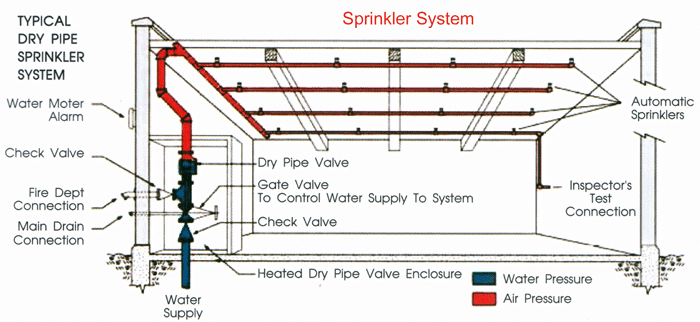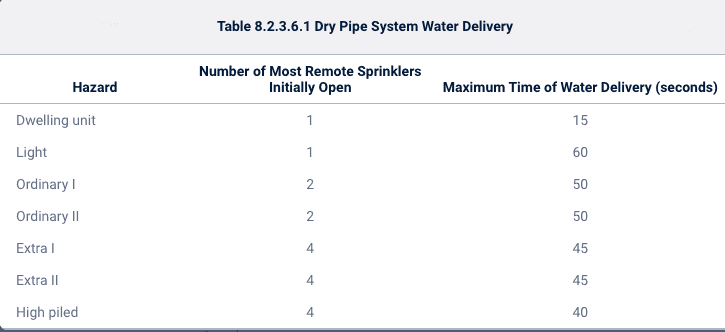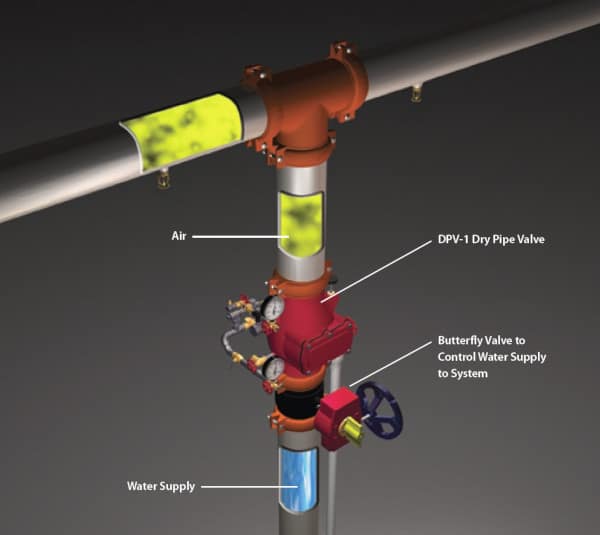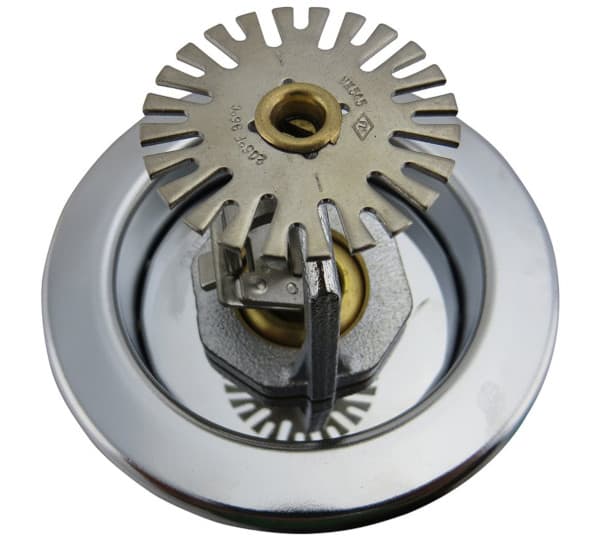Dry sprinkler systems protect people and property in freezing temperatures
Wet sprinkler systems may dominate the fire safety market, but there’s a better solution for certain environments prone to freezing: dry sprinkler systems. Dry sprinklers provide the coverage you need in areas where the temperature drops to 40°F or below, without the fear of frozen, blocked, or burst pipes. And because they don’t always have water running through most of the pipe network, they’re also sometimes used for structures with sensitive or expensive contents.
This first piece in a series explains dry sprinkler systems, including how they work and their advantages and disadvantages over wet systems. Later installments cover components and installation, inspection, testing, and maintenance requirements, and special considerations when installing dry systems.
Are you looking to buy accessories and equipment for your building’s fire sprinkler system? QRFS offers a range of dry sprinkler heads available on special order. Simply give us a call at 888.361.6662 or fill out our contact form.
You can also view our in-stock selection of sprinkler gauges, valves, supervisory switches, and other system components.
Why choose a dry sprinkler system?
Simple and reliable wet pipe sprinkler systems are usually the first choice in fire protection. When a fire causes one or more of the connected sprinklers to activate, water immediately discharges from the sprinkler head thanks to piping that’s filled with pressurized water. But these systems pose challenges when they (or sections of them) are installed in environments that experience freezing temperatures.
If it’s difficult to reliably climate control areas that surround the network of pipes, designers must attempt to thoroughly insulate the pipe or use heat tracing to keep it warm. Unfortunately, this isn’t always possible or cost-effective in large wet systems. Antifreeze is also an option, though this involves complex safety and materials requirements and phase-out issues that you can read about here.
Some building owners also hesitate to place wet systems in areas with sensitive equipment or documents, for fear that leaks in the piping or other malfunctions could cause significant property damage. Though, preaction systems (covered below) are often used for that purpose.
Dry sprinkler systems address many of these challenges because they don’t store water in their sprinkler piping. Instead, pressurized air or nitrogen holds back the water supply at a main dry pipe valve located in a heated space. The pressurization is maintained via an air compressor or a closed, compressed air system. When a fire breaks out and one or more of the sprinklers are activated by rising temperatures, the compressed air in the pipe is released.
The subsequent drop in gas pressure causes the dry pipe valve to open, letting water flow into the pipes and out the open sprinklers. An alarm line connected to the valve activates as soon as the valve opens. Recently, there’s been a movement to phase out pressurized air in favor of nitrogen in dry sprinkler piping because it doesn’t have oxygen that will mix with any residual water and cause corrosion.

Dry sprinkler systems should not be confused with preaction systems, which also use air or nitrogen in their pipes. In preaction sprinklers, the water is only released after an electrically-operated valve is opened by independent flame, heat, or smoke detection, or some combination of sprinkler and alarm activation. Preaction sprinkler systems are typically used to protect particularly sensitive areas such as museums or those containing servers or communications equipment.
The National Fire Protection Association (NFPA) outlines the basic rationale for using these systems in NFPA 13: Standard for the Installation of Sprinkler Systems:
From the 2022 edition of NFPA 13
16.4.1.1* Where any portion of a system is subject to freezing and the temperatures cannot be reliably maintained at or above 40°F (4°C), the system shall be installed as a dry pipe or preaction system.
Getting to know the dry pipe valve
Dry pipe valves are installed at the end of a fire sprinkler riser, acting as a sentry that keeps the water supply from entering the gas-pressurized network of pipes until it’s needed. It’s critical to place the dry pipe valve in an area where the temperature can’t drop below 40 degrees F. Otherwise, ice can form in the water supply, creating a blockage that prevents flow, even if the valve opens.
Some key things about dry pipe valves and pressure:
- As noted above, a pressure difference holds dry pipe valves closed — the sprinkler piping generally has a pressure five times higher than the water supply when the valve is shut. A typical pressure on the system side is 40 psi, which must fall to 6 psi to open the dry pipe valve.
- A low-pressure switch sends an alarm if the air pressure on the system side drops 10 psi below normal. The activation of this switch doesn’t necessarily mean that a sprinkler head has opened — pressure drops can also be caused by problems like leaks or compressor failure. Quick inspections can fix the issue before the pressure drops enough for the dry pipe valve to open. NFPA 72: National Fire Alarm and Signaling Code (2022: 17.17.2.2.2) requires air pressure to be monitored so changes of 10 psi below the nominal value are quickly detected, unless “otherwise permitted by the manufacturer’s published installation instructions.”
- A small amount of priming water can be used to create a better seal in some dry pipe valve models.
- Dry pipe valves include an intermediate chamber with a water flow switch and an alarm port, which often connects to a water motor gong or electric alarm bell outside the building. This piping section usually does not contain water and is not pressurized.
Delayed fill of dry pipe is a drawback and a benefit
The additional steps involved in triggering a dry sprinkler system create a delay of up to 60 seconds between the activation of the sprinkler and water reaching the sprinkler head. As mentioned above, slight drops in pressure that are not caused by sprinkler activation can be detected and issues can be fixed before the system floods with water. Nevertheless, the pipes must fill and sprinklers activate quickly enough to stop a fire from spreading.
NFPA 13 details time requirements for water delivery in dry systems that correspond to the size of the system and the building’s hazard classification:
From the 2022 edition of NFPA 13
8.2.3.2 System size shall be such that initial water is discharged from the system test connection in not more than 60 seconds, starting at the normal air pressure on the system and at the time of fully opened inspection test connection.
8.2.3.6.1 Calculations for dry pipe system water delivery shall be based on the hazard shown in Table 8.2.3.6.1.

Accessories called accelerators can help the dry valve operate faster. By redirecting airflow in the piping, they reduce pressure faster and speed up the opening time of the valve.
Flow switches, which send an alarm to a fire alarm panel and/or fire department when water flows through the piping, are also required. NFPA 13 (16.11.3.4) specifically prohibits paddle-type (vane-type) waterflow switches in anything except wet systems; the flow is so strong when the dry pipe valve opens that it’s likely to damage or remove their paddles. Pressure-type switches must be used.
Additional accessories can also enhance the operation of a dry sprinkler system:
- Air-maintenance devices maintain adequate pressure in the sprinkler piping by adding air when a small pressure loss is detected.
- Air dryers remove the moisture inside the sprinkler piping, which can lead to corrosion.
Where should dry sprinkler systems be used?
Put simply, any large outdoor or unheated structure subject to freezing temperatures that needs sprinkler protection can rely on a dry (or preaction) sprinkler system. Using a wet system (without heat tracing or other measures) in these environments risks frozen, blocked, and bursting pipes — rendering the system useless (or worse, with spilled water) and putting people and property in danger. The most common uses for dry sprinklers include:
- Drive-through loading areas or loading docks
- Unheated warehouses
- Garden or supply centers
- Walk-in refrigerators, commercial freezers, and cooler boxes
- Exposed parking garages
- Unconditioned attics
- Places with water-sensitive storage
Codes and standards govern sprinkler installation
Building and fire codes — including NFPA 5000: Building Construction and Safety Code, the International Building Code (IBC), local ordinances, and NFPA 101: Life Safety Code — mandate the use of some type of automatic sprinkler system in buildings based on factors such as its height and size, occupancy group, and occupant load. Generally speaking, these systems are required in most new commercial buildings that exceed 5,000 square feet and existing structures that expand to over 12,000 square feet.
But even where fire sprinklers aren’t mandated, the codes and standards offer incentives that could significantly lower other construction costs if you install them, including using less expensive building materials in sprinklered buildings, longer egress paths, larger floor-area limitations, and fewer requirements for fire-rated construction.
The NFPA 13 standard applies for most of these “commercial” applications, even if the installation was voluntary and not required by a code. It includes a host of specific requirements for dry system installation that we’ll cover in a subsequent blog.

Advantages of dry sprinkler systems
Peace of mind in freezing temperatures. Dry sprinkler systems provide automatic protection in spaces where freezing temperatures would make wet sprinkler systems impractical.
Less chance of water damage. Lack of water in the piping, when there isn’t a fire, makes surface condensation and dripping less likely — a key consideration in areas where water-sensitive materials are stored. Pipes won’t be compromised by expanding and bursting in freezing temperatures, and any form of compromised pipes also won’t instantly pour water onto assets, although floods aren’t out of the question if damage causes the air pressure to drop quickly enough to activate the system.
Over time, corrosion can cause tiny pinholes to form in the piping, making the system’s air pressure drop. If the air compressor can’t replace the gas as fast as it’s escaping, the system will trip and water will enter the pipe and leak through the holes — sometimes in a drip, but potentially in a gush that drenches assets.
Corrosion is often caused by small amounts of residual water collecting along the bottom of the piping and other low points within the system. It’s important to make sure the system is properly pitched so any water drains back to the riser and designated low points. Draining the system every quarter to remove moisture and regularly inspecting the pipes for damage are also important.
If the system is monitored according to NFPA rules, you will be notified when any issue causes the air pressure to drop more than 10 PSI, alerting you to minor issues before they activate the dry pipe valve.
Disadvantages of dry sprinkler systems
- Increased complexity. Dry sprinkler systems require additional control equipment and air pressure supply components, making them more technically complex than wet sprinklers.
- Higher costs. This added complexity means dry sprinkler systems are more expensive to install and maintain. However, they may still cost less than climate conditioning a space subject to freezing temperatures and certainly dealing with water damage.
- Less design flexibility. NFPA 13 (8.2.3.4) caps the maximum capacity of an individual system that has a quick-opening device at 750 gallons; otherwise, dry pipe systems must meet sizing requirements that depend on achieving needed water-delivery times based on hazard (8.2.3.5). These rules may give owners less flexibility to expand the system.
- Slight delay in fire response. As mentioned, up to 60 seconds may pass from the time a dry sprinkler opens until the fire is showered with water, letting the fire spread slightly longer than a wet sprinkler system would.
Properly-maintained dry sprinkler systems are an effective fire protection solution
Despite some additional measures and costs, dry sprinkler systems are often the best automatic fire protection solution for properties where the ambient temperature is cold enough to freeze the water in a wet sprinkler system. The lack of water in their piping also makes them ideal for areas where leaks and sprinkler malfunctions can damage some assets.
Check out the next installments in our review of dry sprinkler systems, where we explore components and installation, testing, and maintenance requirements, including an in-depth look at how to prevent corrosion.

If you’re looking to buy components for your dry sprinkler system, QRFS offers a range of dry sprinkler heads available on special order. Simply give us a call at 888.361.6662 or email support@qrfs.com and we’d be happy to assist.
We also stock sprinkler gauges, valves, switches, and other parts that are applicable in dry systems.
This blog was originally posted at blog.QRFS.com. If this article helped you, check us out at Facebook.com/QuickResponseFireSupply or on Twitter @QuickResponseFS.

